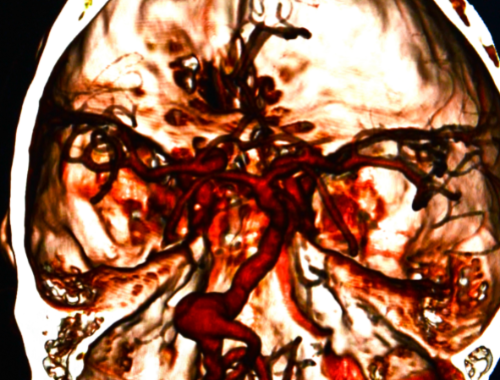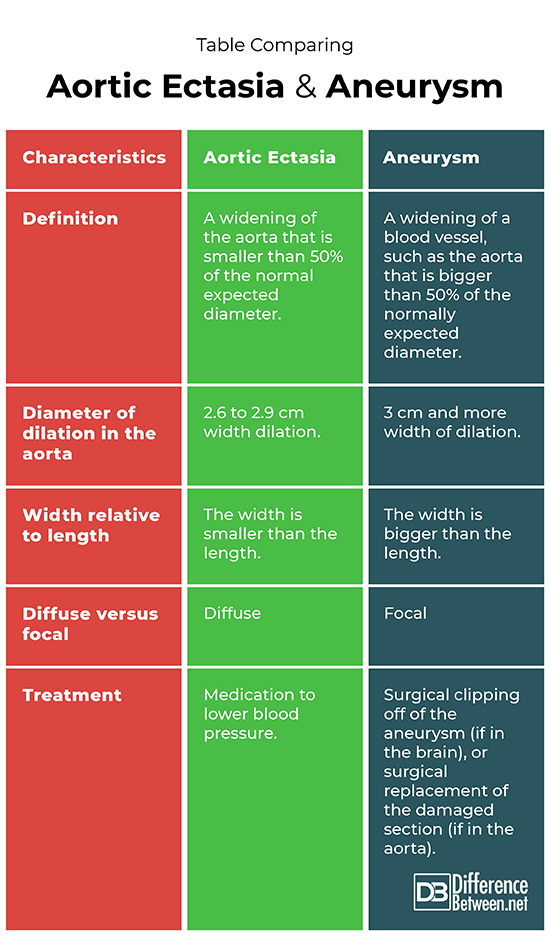Difference Between Aortic Ectasia and Aneurysm
An aortic ectasia is when there is a section of the aorta that increases in width but by less than 50% of the normal width. An aneurysm is when a blood vessel widens to 50% and more of the original diameter of the vessel.

What is Aortic ectasia?
Definition:
An aortic ectasia is when there is a widened area of the aorta that develops in which the region is not more than 50% of the original diameter.
Causes:
Atherosclerosis is a major cause of aortic ectasia but it is also a complication of the disorder primary aldosteronism (a type of hypertension related to the hormone aldosterone).
Diagnosis and symptoms:
An ectasia often has no symptoms when it is in the aorta because it is only a slight widening of the vessel. Diagnosis can be made by an ultrasound of the aorta in which the widened section of the vessel is noticed and measured. An ectasia is longer than it is wide and it is diffuse compared with an aneurysm.
Treatment:
Medication that decreases blood pressure is often used to help prevent the vessel wall from widening further.

What is Aneurysm?
Definition:
An aneurysm is a widened section of a blood vessel that often bulges outwards; it is more than 50% of the diameter of the normal vessel and is in a focused area.
Causes:
Hypertension and atherosclerosis are causes of an aneurysm as are other disorders such as Ehlers-Danlos syndrome and Marfan’s syndrome. Trauma and infection can sometimes cause an aneurysm.
Diagnosis and symptoms:
Unless an aneurysm dissects or ruptures it usually gives no symptoms. It may depend also on where the aneurysm is because this can occur in other blood vessels such as the coronary vessels of the heart. Coronary artery aneurysms can cause some symptoms similar to those of a heart attack. Imaging tests such as angiograms, ultrasound, CT scans, or MRI can show that an aneurysm is present.
Treatment:
Treatment depends on where the aneurysm is. If in the brain, a surgical clip is used to close off the aneurysm. In the aorta, surgery may be needed once the aneurysm reaches a certain size. Surgical intervention to replace the damaged section with a graft helps to prevent the life-threatening dissection and rupture of the vessel.
Difference between Aortic ectasia and Aneurysm?
Definition
An aortic ectasia is a widening of the aorta that is smaller than 50% of normal for the vessel. An aneurysm is when there is a widening of a blood vessel, such as the aorta that is bigger than 50% of the expected diameter.
Diameter of dilation in the aorta
Ectasia of the aorta is diagnosed when the width of the dilated region is 2.6 to 2.9 cm wide. An aneurysm of the aorta is diagnosed when the width of the dilated region is 3 cm and more.
Width relative to length
In the case of aortic ectasia, the width of the bulge is smaller than the length. In the case of an aneurysm, the width is bigger than the length.
Diffuse versus focal
An aortic ectasia is usually seen as a diffuse swollen area. An aneurysm is considered to be a focal swollen area.
Treatment
Medicine that lowers the blood pressure is how aortic ectasia is usually treated. Treatment of an aneurysm varies depending on where it is located in the body; surgical clipping off of the aneurysm (if in the brain), or surgical replacement of the damaged section (if in the aorta) are treatment options for an aneurysm.
Table comparing Aortic ectasia and Aneurysm

Summary of Aortic ectasia Vs. Aneurysm
- An aortic ectasia is a swollen section of the aorta that is not very big and is usually longer than it is wide.
- An aneurysm is a focused area of a blood vessel that bulges out and needs surgical repair.
- An ectasia can develop further into an aneurysm.
FAQ
Is ectasia the same as an aneurysm?
An ectasia is not the same as an aneurysm because it is not as wide of an area. However, if the vessel widens more, it may become an aneurysm.
Is aortic ectasia and aneurysm the same?
No, an aortic ectasia is longer than it is wider, and it is narrower in diameter than an aneurysm. An aortic aneurysm is more of a localized bulge that is wider than it is long.
What is aortic ectasia?
This is when the aorta increases in width but by less than 3 cm and by less than half the original width of the aorta.
How serious is ectasia of the aorta?
Ectasia is not always serious unless the width continues to expand.
Is aortic ectasia common?
Aortic ectasia is not common in young healthy people but it does become more likely as we age. However, ectasia of the aorta and aneurysms develop in less than 1% of the population, so are quite rare.
How do you fix an aortic ectasia?
A small ectasia may be treated medically with blood pressure drugs and often doctors choose to wait and see what happens. If the area continues to expand to form an aneurysm, then surgery will be indicated. When surgery is done the focus is on replacing the damaged part of the aorta with a graft.
- Difference Between Rumination and Regurgitation - June 13, 2024
- Difference Between Pyelectasis and Hydronephrosis - June 4, 2024
- Difference Between Cellulitis and Erysipelas - June 1, 2024
Search DifferenceBetween.net :
Leave a Response
References :
[0]Bollati, Martina, et al. "Atrial Fibrillation and Aortic Ectasia as Complications of Primary Aldosteronism: Focus on Pathophysiological Aspects." International Journal of Molecular Sciences 23.4 (2022): 2111.
[1]Díaz-Zamudio, Mariana, et al. "Coronary artery aneurysms and ectasia: role of coronary CT angiography." Radiographics 29.7 (2009): 1939-1954.
[2]Saliba, Emile, et al. "The ascending aortic aneurysm: When to intervene?" IJC Heart & Vasculature 6 (2015): 91-100.
